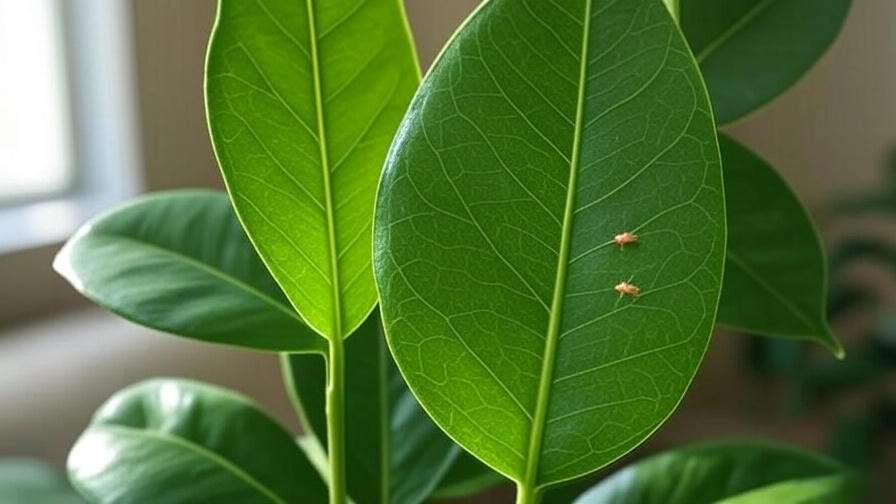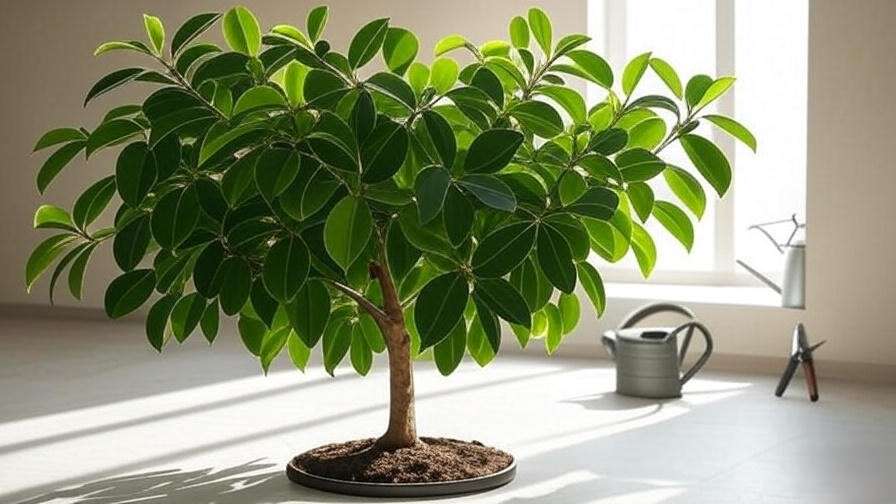Picture this: You bring home a stunning ficus tree, its glossy leaves promising to transform your living space into a lush, green oasis. But a few weeks later, those vibrant leaves start dropping, leaving you puzzled and frustrated. Sound familiar? Don’t worry—learning how to care for a ficus tree is easier than you think, and we’re here to guide you every step of the way! 😊 As a plant care enthusiast with years of experience nurturing ficus trees, I’ve teamed up with horticultural experts to create this comprehensive guide. Whether you’re a beginner or a seasoned plant parent, you’ll find actionable tips to keep your ficus thriving, from mastering light and watering to troubleshooting common issues. Let’s dive in and unlock the secrets to a healthy, vibrant ficus tree! 🌳
Section 1: Understanding Your Ficus Tree 🌳
What Is a Ficus Tree? 🤔
Ficus trees, belonging to the Ficus genus, are a diverse group of plants celebrated for their lush foliage and versatility as indoor houseplants. With over 800 species, ficus trees like the Ficus benjamina (weeping fig), Ficus lyrata (fiddle-leaf fig), and Ficus elastica (rubber plant) are staples in homes and offices. Their elegant leaves and tree-like growth make them a favorite for adding a touch of nature to any space. However, their care needs can be specific, and understanding these requirements is the first step to ensuring their long-term health. Proper ficus tree care starts with knowing your plant’s unique traits and preferences.
Popular Ficus Varieties for Indoor Growing 🌿
Not all ficus trees are created equal! Here’s a quick look at the most popular varieties for indoor growing, each with distinct characteristics:
- Ficus benjamina (Weeping Fig): Known for its graceful, drooping branches and small, glossy leaves. It loves bright, indirect light and moderate humidity.
- Ficus lyrata (Fiddle-Leaf Fig): A trendy choice with large, violin-shaped leaves. It thrives in bright light but is sensitive to overwatering.
- Ficus elastica (Rubber Plant): Features bold, dark green leaves and a striking, upright form. It prefers consistent moisture and warmth.
- Ficus microcarpa (Ginseng Ficus): Often grown as a bonsai, with thick roots and small leaves. It’s forgiving but needs stable conditions.
| Variety | Light Needs | Watering Frequency | Humidity Preference |
|---|---|---|---|
| Ficus benjamina | Bright, indirect | When topsoil is dry | Moderate (50–60%) |
| Ficus lyrata | Bright, indirect | Sparingly, avoid soggy | High (60%+) |
| Ficus elastica | Bright, indirect | Moderate, consistent | Moderate to high |
| Ficus microcarpa | Bright, indirect | When topsoil is dry | Moderate |
Understanding your ficus variety sets the foundation for tailored care, ensuring lush growth and vibrant leaves.
Section 2: Essential Ficus Tree Care Tips 🌞
Light Requirements for a Thriving Ficus ☀️
Light is the lifeblood of a ficus tree. Most varieties thrive in bright, indirect light, mimicking their natural tropical habitats. Place your ficus near a north- or east-facing window with filtered sunlight, or use sheer curtains to diffuse harsh rays from south- or west-facing windows. Too little light leads to leggy growth and leaf drop, while direct sunlight can scorch leaves, causing brown, crispy edges.
Pro Tip: Rotate your ficus every few weeks to ensure even light exposure, promoting balanced growth. If your space lacks natural light, consider a grow light (6500K spectrum) for 10–12 hours daily. Avoid placing your ficus in a dim corner—it’s a recipe for a sad, droopy plant! 😢

Watering Your Ficus the Right Way 💧
Watering is where many ficus owners stumble. The golden rule? Water when the top 1–2 inches of soil feel dry. For most indoor environments, this means watering every 7–10 days, but adjust based on your home’s conditions. Use room-temperature water and ensure your pot has drainage holes to prevent water from pooling at the bottom.
Here’s a simple watering guide:
- Check the soil with your finger or a moisture meter.
- Water evenly until it drains from the bottom, then empty the saucer.
- Avoid letting the soil stay soggy, as this leads to root rot.
Signs of Trouble:
- Overwatering: Yellowing leaves, mushy stems, or a musty smell.
- Underwatering: Dry, curling leaves or excessive leaf drop.
Expert Insight: “Consistency is key,” says Dr. Emily Carter, a horticulturist with 15 years of experience. “Ficus trees hate surprises, so stick to a routine and monitor soil moisture closely.”

Humidity and Temperature Needs 🌡️
Ficus trees hail from humid, tropical climates, so they prefer 50–60% humidity or higher. In dry indoor environments (especially during winter), boost humidity with these methods:
- Misting: Lightly mist leaves 2–3 times a week.
- Pebble Tray: Place a tray of water with pebbles under the pot (ensure the pot isn’t sitting in water).
- Humidifier: Use a small humidifier for consistent moisture.
Maintain temperatures between 65–75°F (18–24°C), and avoid placing your ficus near drafts, air vents, or heaters. Sudden temperature swings can trigger leaf drop, so keep conditions stable.
Real-World Example: In my own home, I struggled with my Ficus lyrata during winter until I placed a humidifier nearby. Within weeks, the leaves perked up, and new growth appeared! 🌿

Soil and Potting Best Practices 🪴
A well-draining, nutrient-rich potting mix is essential for ficus health. Opt for a mix of peat, perlite, and pine bark, or purchase a high-quality houseplant potting soil. Repot your ficus every 1–2 years or when roots start circling the pot’s interior (a sign it’s pot-bound).
Repotting Guide:
- Choose a pot 1–2 inches larger in diameter with drainage holes.
- Gently remove the plant, shaking off excess soil.
- Trim any damaged roots and place in fresh soil.
- Water lightly and keep the plant in indirect light for a week to reduce transplant shock.
Pro Tip: Always use a pot with drainage holes to prevent water buildup, which can lead to root rot.

Fertilizing for Optimal Growth 🌿
To fuel lush growth, fertilize your ficus during the growing season (spring and summer) with a balanced, water-soluble fertilizer (e.g., 10-10-10) diluted to half strength. Apply every 4–6 weeks, following package instructions. Avoid fertilizing in fall and winter when growth slows.
Warning: Over-fertilizing can cause leaf burn or leggy growth. If you notice white crust on the soil (fertilizer buildup), flush the pot with water and reduce feeding.
Section 3: Pruning and Shaping Your Ficus ✂️
Why Pruning Is Essential for Ficus Health 🌳
Pruning keeps your ficus looking full and healthy while preventing leggy growth. It also encourages new branches and maintains your desired shape, whether it’s a bushy shrub or a sleek tree. The best time to prune is early spring, before the growing season kicks into high gear.
Safety First: Use clean, sharp pruning shears to avoid spreading disease. Wipe blades with rubbing alcohol between cuts.
Step-by-Step Pruning Guide 🪴
- Assess the Plant: Identify dead, damaged, or overly long branches.
- Trim Strategically: Cut just above a leaf node at a 45-degree angle to encourage new growth.
- Shape the Plant: Remove crossing branches to improve air circulation and maintain your desired aesthetic.
- Clean Up: Remove fallen leaves to prevent pests and keep the area tidy.
Visual Aid Idea: Check out a pruning diagram or video on our site for a visual guide to perfect cuts! 🌟
Section 4: Common Ficus Tree Problems and Solutions 🐛
Troubleshooting Leaf Drop and Other Issues 😢
Leaf drop is the #1 complaint among ficus owners, often caused by stress from improper light, watering, or temperature changes. Here’s a quick troubleshooting guide:
- Leaf Drop: Check for low light, overwatering, or drafts. Move to a brighter spot, adjust watering, and stabilize conditions.
- Yellowing Leaves: Likely overwatering or poor drainage. Let soil dry out and ensure proper drainage.
- Brown, Crispy Edges: Indicates low humidity or too much direct sun. Increase humidity and move to indirect light.
Pest Control for Ficus Trees 🕷️
Ficus trees can attract pests like spider mites, scale, and mealybugs. Look for sticky residue, webbing, or small bugs on leaves.
- Neem Oil: Mix with water and spray on leaves every 7–10 days.
- Insecticidal Soap: Apply to affected areas, then wipe leaves clean.
- Prevention: Wipe leaves with a damp cloth weekly to remove dust and deter pests.
Pro Tip: Isolate a pest-infested ficus to prevent spreading to other plants.

Dealing with Root Rot and Overwatering 💦
Root rot, caused by overwatering, is a serious issue. Symptoms include mushy roots, a foul odor, or wilting despite wet soil. To save your ficus:
- Remove the plant from its pot and inspect roots.
- Trim away black, mushy roots with sterilized shears.
- Repot in fresh, well-draining soil and reduce watering frequency.
Expert Insight: “Root rot is preventable with proper drainage,” says arborist Jane Thompson. “Always check your pot’s drainage holes and avoid letting water sit in the saucer.”
Section 5: Advanced Care Tips for Ficus Enthusiasts 🌟
Propagating Your Ficus Tree 🌱
Propagating a ficus tree is a rewarding way to expand your plant collection or share with friends. The most common methods are stem cuttings and air layering, both of which can yield healthy new plants with proper care.
Stem Cutting Propagation Guide:
- Select a Healthy Stem: Choose a 4–6 inch stem with 2–3 leaves, cutting just below a node.
- Prepare the Cutting: Remove lower leaves and dip the cut end in rooting hormone (optional for faster rooting).
- Plant in Soil: Place the cutting in a small pot with moist, well-draining soil (e.g., peat and perlite mix).
- Create a Humid Environment: Cover with a plastic bag or propagation dome to lock in moisture, ensuring good airflow to prevent mold.
- Provide Light and Warmth: Place in bright, indirect light at 70–75°F (21–24°C). Roots typically form in 4–6 weeks.
- Transplant: Once roots are 1–2 inches long, move to a larger pot and treat as a mature ficus.

Air Layering (for Larger Ficus):
- Make a small upward cut on a healthy branch, insert a toothpick to keep it open, and wrap with moist sphagnum moss.
- Cover with plastic wrap to retain moisture and check weekly. Roots should form in 6–8 weeks.
- Once rooted, cut below the new roots and pot in fresh soil.
Pro Tip: Patience is key! Keep the soil consistently moist but not soggy, and avoid disturbing the cutting during rooting. 🌿
Seasonal Care Adjustments 🍂
Ficus trees respond to seasonal changes, so adjusting care routines ensures year-round health:
- Spring/Summer: This is the growing season. Increase watering slightly, fertilize every 4–6 weeks, and provide ample bright, indirect light. Prune to encourage new growth.
- Fall/Winter: Growth slows, so reduce watering (check soil dryness more carefully) and stop fertilizing. Protect from cold drafts and maintain humidity, as indoor heating can dry out air.
Seasonal Care Checklist:
- Spring: Repot if needed, prune for shape, and resume fertilizing.
- Summer: Monitor for pests, rotate for even light exposure, and mist regularly.
- Fall: Reduce watering and check for drafts near windows.
- Winter: Use a humidifier and keep away from heaters or vents.
Real-World Example: Last winter, my Ficus benjamina struggled near a drafty window. Moving it 3 feet away and adding a pebble tray restored its vibrancy by spring! 😊

Section 6: FAQs About Ficus Tree Care ❓
Here are answers to common questions about how to care for a ficus tree, drawn from real searcher queries:
Q1: How often should I water my ficus tree? 💧
A: Water when the top 1–2 inches of soil feel dry, typically every 7–10 days. Adjust based on your home’s light, humidity, and temperature. Overwatering is a common mistake, so always check soil moisture first.
Q2: Why is my ficus tree losing leaves? 🍃
A: Leaf drop often signals stress from low light, overwatering, or drafts. Ensure bright, indirect light, let soil dry slightly between waterings, and keep the plant away from cold air or sudden temperature changes.
Q3: Can ficus trees grow outdoors? 🌞
A: Yes, in warm climates (USDA zones 10–12), ficus trees can thrive outdoors in partial shade. Protect from frost and strong winds, and bring indoors during cold snaps if potted.
Q4: How do I revive a struggling ficus? 🩺
A: Identify the issue (e.g., leaf drop, yellowing, or pests). Adjust light, water, and humidity as needed. Trim dead growth, repot if root-bound, and maintain stable conditions. With consistent care, most ficus trees recover within weeks.
Q5: Are ficus trees toxic to pets? 🐶
A: Yes, ficus trees are toxic to cats, dogs, and other pets if ingested, causing vomiting or irritation. Keep out of reach or choose pet-safe plants if this is a concern.
Section 7: Expert Insights and Pro Tips 🌟
To elevate your ficus care game, here are insights from the pros:
- Quote from an Expert: “Ficus trees thrive on consistency,” says Dr. Maria Lopez, a certified arborist with 20 years of experience. “Stick to a stable environment and routine, and your ficus will reward you with lush growth.”
- Personal Anecdote: My Ficus lyrata once dropped half its leaves after a move. By placing it in bright, indirect light, cutting back on water, and misting daily, I nursed it back to health in just two months. It’s now the centerpiece of my living room! 🌳
- Lesser-Known Tip: Wipe ficus leaves with a damp cloth every 1–2 weeks to remove dust. This boosts photosynthesis and keeps leaves glossy, enhancing both health and aesthetics.
Bonus Tip: If your ficus is growing unevenly, stake it gently with a bamboo stick to support upright growth. This works wonders for Ficus elastica or leggy Ficus benjamina.
Conclusion: Your Path to a Thriving Ficus Tree 🎉
Caring for a ficus tree doesn’t have to be daunting. By providing bright, indirect light, watering only when the soil is dry, maintaining moderate humidity, and pruning regularly, you’ll set your ficus up for success. Whether you’re nurturing a Ficus lyrata’s bold leaves or a Ficus benjamina’s delicate branches, consistency is your best friend. 🌿 Use this guide to troubleshoot issues like leaf drop or pests, and don’t be afraid to experiment with propagation to grow your collection.
Ready to make your ficus the star of your home? Share your ficus care stories or questions in the comments below—we’d love to hear from you! 😊 For more plant care tips, check out our guides on caring for fiddle-leaf figs or best houseplants for low light.













